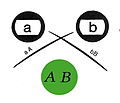Ouchterlony double immunodiffusion
Ouchterlony double immunodiffusion (also known as double gel diffusion or passive double immunodiffusion) is a laboratory technique used in immunology to detect or quantify antigens and antibodies in a sample. This method relies on the principle of immunodiffusion, where antibodies and antigens diffuse through a semi-solid medium, typically agarose, and form precipitin lines where they meet and bind to each other. The technique was developed by Örjan Ouchterlony in 1948, making it one of the earliest tools for studying antigen-antibody reactions.
Principle[edit]
In Ouchterlony double immunodiffusion, both antigen and antibody are allowed to diffuse into the agarose gel from separate wells. As they diffuse towards each other, antigen-antibody complexes form when the antigen encounters its specific antibody. This interaction results in the formation of a visible precipitin line in the gel. The pattern and intensity of these lines can be analyzed to determine the presence, identity, and relative concentration of antigens or antibodies in the samples.
Procedure[edit]
The procedure for Ouchterlony double immunodiffusion involves several steps:
- A gel is prepared by pouring melted agarose into a petri dish or a similar flat surface.
- Once the gel has solidified, wells are punched into the agar at specific distances from each other.
- The antigen and antibody solutions are then carefully pipetted into their respective wells.
- The petri dish is incubated at room temperature or in a humid chamber to allow diffusion to occur.
- After sufficient time has passed for diffusion and precipitin line formation, the results are analyzed.
Interpretation of Results[edit]
The interpretation of results in Ouchterlony double immunodiffusion is based on the pattern of precipitin lines formed:
- A single line between a well containing antigen and a well containing antibody indicates a specific reaction.
- The absence of a line suggests that there is no antigen-antibody reaction, possibly due to the absence of the antigen or antibody in the samples.
- Crossed lines indicate the presence of more than one antigen in the sample reacting with the antibody.
- The convergence of lines from different antigen wells towards a single antibody well suggests that the antigens are similar or share common epitopes.
Applications[edit]
Ouchterlony double immunodiffusion has been widely used for:
- Identifying unknown antigens or antibodies.
- Comparing antigenic similarities and differences among various samples.
- Estimating the concentration of antigens or antibodies through semi-quantitative analysis.
- Diagnosing diseases by detecting specific antigens or antibodies in patient samples.
Advantages and Limitations[edit]
Advantages:
- Simple and inexpensive technique.
- Requires no special equipment.
- Can visually demonstrate antigen-antibody reactions.
Limitations:
- Less sensitive compared to other immunological methods such as ELISA or Western blot.
- Quantitative analysis is only semi-quantitative and less precise.
- Time-consuming, as diffusion can take several hours to days.
See Also[edit]

This article is a immunology stub. You can help WikiMD by expanding it!
-
Ouchterlony double immunodiffusion
-
Antigen identification pattern
-
No identification pattern
-
Non-identification pattern
Ad. Transform your life with W8MD's Budget GLP-1 injections from $75


W8MD offers a medical weight loss program to lose weight in Philadelphia. Our physician-supervised medical weight loss provides:
- Weight loss injections in NYC (generic and brand names):
- Zepbound / Mounjaro, Wegovy / Ozempic, Saxenda
- Most insurances accepted or discounted self-pay rates. We will obtain insurance prior authorizations if needed.
- Generic GLP1 weight loss injections from $75 for the starting dose.
- Also offer prescription weight loss medications including Phentermine, Qsymia, Diethylpropion, Contrave etc.
NYC weight loss doctor appointmentsNYC weight loss doctor appointments
Start your NYC weight loss journey today at our NYC medical weight loss and Philadelphia medical weight loss clinics.
- Call 718-946-5500 to lose weight in NYC or for medical weight loss in Philadelphia 215-676-2334.
- Tags:NYC medical weight loss, Philadelphia lose weight Zepbound NYC, Budget GLP1 weight loss injections, Wegovy Philadelphia, Wegovy NYC, Philadelphia medical weight loss, Brookly weight loss and Wegovy NYC
|
WikiMD's Wellness Encyclopedia |
| Let Food Be Thy Medicine Medicine Thy Food - Hippocrates |
Medical Disclaimer: WikiMD is not a substitute for professional medical advice. The information on WikiMD is provided as an information resource only, may be incorrect, outdated or misleading, and is not to be used or relied on for any diagnostic or treatment purposes. Please consult your health care provider before making any healthcare decisions or for guidance about a specific medical condition. WikiMD expressly disclaims responsibility, and shall have no liability, for any damages, loss, injury, or liability whatsoever suffered as a result of your reliance on the information contained in this site. By visiting this site you agree to the foregoing terms and conditions, which may from time to time be changed or supplemented by WikiMD. If you do not agree to the foregoing terms and conditions, you should not enter or use this site. See full disclaimer.
Credits:Most images are courtesy of Wikimedia commons, and templates, categories Wikipedia, licensed under CC BY SA or similar.
Translate this page: - East Asian
中文,
日本,
한국어,
South Asian
हिन्दी,
தமிழ்,
తెలుగు,
Urdu,
ಕನ್ನಡ,
Southeast Asian
Indonesian,
Vietnamese,
Thai,
မြန်မာဘာသာ,
বাংলা
European
español,
Deutsch,
français,
Greek,
português do Brasil,
polski,
română,
русский,
Nederlands,
norsk,
svenska,
suomi,
Italian
Middle Eastern & African
عربى,
Turkish,
Persian,
Hebrew,
Afrikaans,
isiZulu,
Kiswahili,
Other
Bulgarian,
Hungarian,
Czech,
Swedish,
മലയാളം,
मराठी,
ਪੰਜਾਬੀ,
ગુજરાતી,
Portuguese,
Ukrainian



